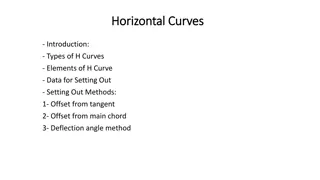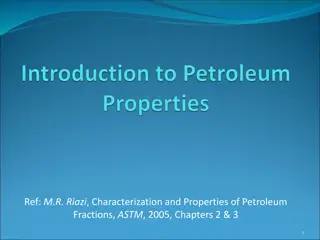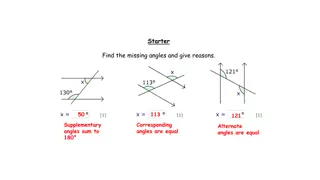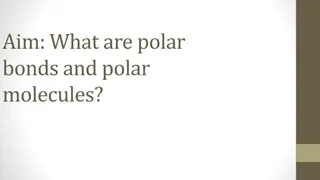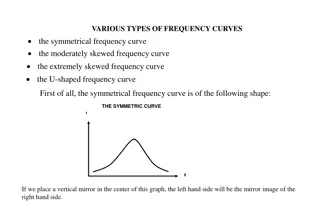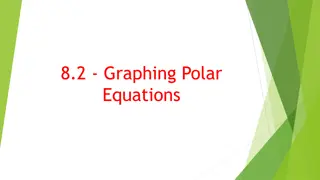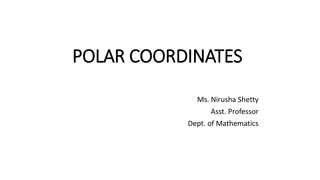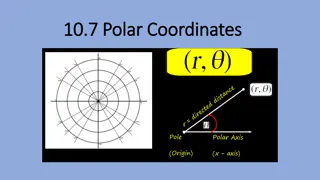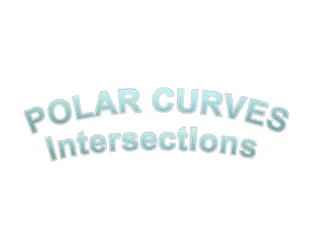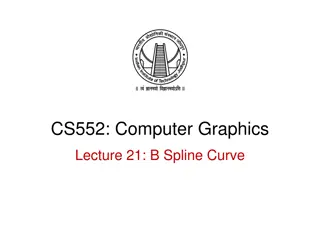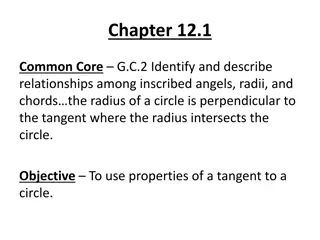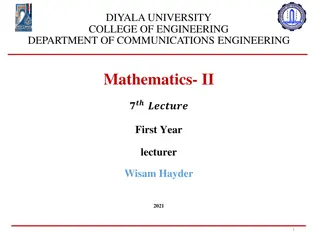
Exploring Polar Coordinates and Tangents
"Learn how to work with polar coordinates, convert them to parametric form, find tangents to curves, and differentiate in polar equations. Understand the significance of initial lines, integration for area calculation, and differentiating to find tangents. Utilize parametric form for straightforward processes."
Download Presentation

Please find below an Image/Link to download the presentation.
The content on the website is provided AS IS for your information and personal use only. It may not be sold, licensed, or shared on other websites without obtaining consent from the author. If you encounter any issues during the download, it is possible that the publisher has removed the file from their server.
You are allowed to download the files provided on this website for personal or commercial use, subject to the condition that they are used lawfully. All files are the property of their respective owners.
The content on the website is provided AS IS for your information and personal use only. It may not be sold, licensed, or shared on other websites without obtaining consent from the author.
E N D
Presentation Transcript
Teachings for Exercise 5D Teachings for Exercise 5D
Polar Coordinates If you are given ? = ?(?) in polar form, you can write it parametrically in cartesian form, in terms of ? You can use the Polar equation to find tangents to a curve that are parallel or perpendicular to the original line ? = ?(?)???? ? = ????? ? = ?(?)???? ? = ????? We have looked at integration to find areas beneath polar curves We can now differentiate as with parametric equations This final section looks at differentiating to find tangents to polar curves If ?? tangent at that point on the curve will be horizontal (gradient is 0) ??= 0, then ?? ??= 0 and the ?? ?? ?? ?? ?? ??= It is very similar to what you have done already ie) Differentiating and setting the expression equal to If ?? the tangent at that point on the curve will be vertical (gradient is undefined) ??= 0, then ?? ??= ????????? and 0 With polar equations we use them in a parametric form to make the process more straightforward 5D
?? ??= 0 ???????? ?? ? ? ??????? ???? Polar Coordinates You can use the Polar equation to find tangents to a curve that are parallel or perpendicular to the original line ? = ????? ? = ????? The line from the origin at an angle of 0 is called the initial line ?? ??= ? We have looked at integration to find areas beneath polar curves This final section looks at differentiating to find tangents to polar curves ?? ??= ? It is very similar to what you have done already ie) Differentiating and setting the expression equal to The equation y = rsin represents changes in the vertical direction 0 When dy/d is 0, that means that there is no movement in the vertical direction (the change in y with respect to a change in is 0) With polar equations we use them in a parametric form to make the process more straightforward Therefore, if dy/d is 0, the curve is parallel to the initial line 5D
?? ??= 0 ?? ??= 0 ????????????? ?? ? ? ??????? ???? ???????? ?? ? ? ??????? ???? Polar Coordinates You can use the Polar equation to find tangents to a curve that are parallel or perpendicular to the original line ? = ????? ? = ????? The line from the origin at an angle of 0 is called the initial line We have looked at integration to find areas beneath polar curves This final section looks at differentiating to find tangents to polar curves ?? ??= ? ?? ??= ? It is very similar to what you have done already ie) Differentiating and setting the expression equal to The equation x = rcos represents changes in the horizontal direction 0 When dx/d is 0, that means that there is no movement in the horizontal direction (the change in x with respect to a change in is 0) With polar equations we use them in a parametric form to make the process more straightforward Therefore, if dx/d is 0, the curve is perpendicular to the initial line 5D
?? ??= 0 ?? ??= 0 ????????????? ?? ? ? ??????? ???? ???????? ?? ? ? ??????? ???? Polar Coordinates ? = ????? ? = ????? You can use the Polar equation to find tangents to a curve that are parallel or perpendicular to the original line ? = ?(? + ????) Find the coordinates of the points on: r = a(1 + cos ) Rearrange Where the tangents are parallel to the initial line = 0. ? ? = ????? ????= ? You can substitute this into the equation of the curve to eliminate r ? = ?(1 + ????) Replace r with a term in y and You need to find an expression for y in terms of , before you can use the rules above ? ????= ?(1 + ????) Multiply by sin ? = ?????(1 + ????) Leave a outside the bracket (it is a constant) ? = ?(???? + ????????) 5D
?? ??= 0 ?? ??= 0 ????????????? ?? ? ? ??????? ???? ???????? ?? ? ? ??????? ???? Polar Coordinates ? = ????? ? = ????? Differentiate, using the product rule where necessary (alternatively, sin cos could be written as 1/2sin2 first, which then avoids the need for the product rule) You can use the Polar equation to find tangents to a curve that are parallel or perpendicular to the original line ? = ?(???? + ????????) ?? ??= ?( ???? + ???2? ???2? ) Find the coordinates of the points on: Product rule for sin cos If dy/d is 0, then the expression in the brackets must be 0 ( a cannot be as it is a constant) ???? ???? r = a(1 + cos ) ???2? + ???? ???2? = 0 Replace the term in sin with ???? one in cos (from C2) ???? Where the tangents are parallel to the initial line = 0. ???2? + ???? (1 ???2?) = 0 Group terms 2???2? + ???? 1 = 0 Now differentiate Factorise (2???? 1)(???? + 1) = 0 You can just differentiate the terms inside the bracket, since a is a constant and will just remain the same! ???? =1 2 ?? ???? = 1 5D
?? ??= 0 ?? ??= 0 ????????????? ?? ? ? ??????? ???? ???????? ?? ? ? ??????? ???? Polar Coordinates ? = ????? ? = ????? ???? =1 You can use the Polar equation to find tangents to a curve that are parallel or perpendicular to the original line 2 ?? ???? = 1 Find in the range 0 < 2 Find in the range 0 < 2 ? =? 3 ?? ? Use these to find r so you have the full coordinates ? = ? Find the coordinates of the points on: 3 ? = 0 ? =3? 2 (??? ??? ) r = a(1 + cos ) 3? 2, ? So the curve is parallel to the initial line in these positions: Where the tangents are parallel to the initial line = 0. ??? 0,? 3 (3a/2, /3) ? = ?(? + ????) (0, ) (3a/2,- /3) 5D
?? ??= 0 ?? ??= 0 ????????????? ?? ? ? ??????? ???? ???????? ?? ? ? ??????? ???? Polar Coordinates ? = ????? ? = ????? You can use the Polar equation to find tangents to a curve that are parallel or perpendicular to the original line Find the coordinates and the equations of the tangents to the curve: r = asin2 , 0 /2 So we need to find the equations of the tangents that are parallel to the initial line Where the tangents are: a) Parallel to the initial line b) Perpendicular to the initial line dy/d = 0 As in the previous example, we will need to find an expression for y Give answers to 3 s.f where appropriate: ? = ????? You can actually substitute r straight in if you want to (this was also an option on the previous example!) Sketch it to get an idea of where the tangents will be ? = ????2????? 5D
?? ??= 0 ?? ??= 0 ????????????? ?? ? ? ??????? ???? ???????? ?? ? ? ??????? ???? Polar Coordinates ? = ????? ? = ????? Product rule for sin cos ? = ?(???2?????) You can use the Polar equation to find tangents to a curve that are parallel or perpendicular to the original line ?? ??= ???2? ???? ) ?( ???2????? + 2???2????? If dy/d = 0, then the part in the bracket must be 0 Find the coordinates and the equations of the tangents to the curve: 2???2? ???? ???2????? + 2???2????? = 0 Replace sin2 and cos2 with equivalent expressions from C3 r = asin2 , 0 /2 2???????????? + 2 2???2? 1 ???? = 0 Simplify/Multiply out brackets 2???????2? + 4???2????? 2???? = 0 Where the tangents are: a) Parallel to the initial line b) Perpendicular to the initial line Group terms 6???????2? 2???? = 0 Factorise 2????(3???2? 1) = 0 Solve in the range you re given Give answers to 3 s.f where appropriate: ???2? =1 2???? = 0 3 Now we can differentiate 1 ???? = ? = 0 3 ? = 0.955 5D
?? ??= 0 ?? ??= 0 ????????????? ?? ? ? ??????? ???? ???????? ?? ? ? ??????? ???? Polar Coordinates ? = ????? ? = ????? (2a 2/3,0.955) ? = 0 ?? ? = 0.955 You can use the Polar equation to find tangents to a curve that are parallel or perpendicular to the original line ? = 0 ?? ? =2? 2 3 Find the coordinates and the equations of the tangents to the curve: ? = 0 (0,0) r = asin2 , 0 /2 The equation of this line is just: Where the tangents are: a) Parallel to the initial line b) Perpendicular to the initial line ? = ? Give answers to 3 s.f where appropriate: You can find the value of r for each, and use the sketch to find the equation of the tangent 5D
?? ??= 0 ?? ??= 0 ????????????? ?? ? ? ??????? ???? ???????? ?? ? ? ??????? ???? Polar Coordinates ? = ????? ? = ????? (2a 2/3,0.955) ? = 0 ?? ? = 0.955 You can use the Polar equation to find tangents to a curve that are parallel or perpendicular to the original line ? = 0 ?? ? =2? 2 3 Find the coordinates and the equations of the tangents to the curve: ? = 0 2 1 ???? = ???? = 3 3 r = asin2 , 0 /2 We need to find the equation of the dotted line above (in polar form ) A couple of trig ratios will be useful to us here. We already know that for this point: Hyp ??? ??? Where the tangents are: a) Parallel to the initial line b) Perpendicular to the initial line 1 ???? = 3 3 Opp 2 Give answers to 3 s.f where appropriate: ??? ??? 2 ???? = 3 1 Adj 5D
?? ??= 0 ?? ??= 0 ????????????? ?? ? ? ??????? ???? ???????? ?? ? ? ??????? ???? Polar Coordinates ? = ????? ? = ????? (2a 2/3,0.955) ? = 0 ?? ? = 0.955 You can use the Polar equation to find tangents to a curve that are parallel or perpendicular to the original line ? = 0 ?? ? =2? 2 3 Opp 2a 2/3 Find the coordinates and the equations of the tangents to the curve: ? = 0 2 1 ???? = ???? = 3 3 r = asin2 , 0 /2 You can find the equation of the line in Cartesian form, then substitute it into the link between y and r above The Cartesian form will just be y = a, where a is the height of the line Where the tangents are: a) Parallel to the initial line b) Perpendicular to the initial line ??? = ??? ???? Sub in values ??? =2? 2 2 3 3 Give answers to 3 s.f where appropriate: Calculate 4? ??? = 3 3 So this is the Cartesian equation of the tangent 4? ? = 3 3 5D
?? ??= 0 ?? ??= 0 ????????????? ?? ? ? ??????? ???? ???????? ?? ? ? ??????? ???? Polar Coordinates ? = ????? ? = ????? (2a 2/3,0.955) ? = 0 ?? ? = 0.955 You can use the Polar equation to find tangents to a curve that are parallel or perpendicular to the original line ?? ? ??????? ? = ? = 0 ?? ? =2? 2 3 Find the coordinates and the equations of the tangents to the curve: ? = 0 4? 3 3?????? 4? ? = ? ? = ? = 3 3 r = asin2 , 0 /2 Now use the link between y and r above to turn the equation into a polar form Where the tangents are: a) Parallel to the initial line b) Perpendicular to the initial line ? = ????? Replace y with the expression we calculated 4? 3 3= ????? Give answers to 3 s.f where appropriate: Divide by sin 4? 3 3????= ? Alternative form 4? 3 3?????? ? = 5D
?? ??= 0 ?? ??= 0 ????????????? ?? ? ? ??????? ???? ???????? ?? ? ? ??????? ???? Polar Coordinates ? = ????? ? = ????? You can use the Polar equation to find tangents to a curve that are parallel or perpendicular to the original line Find the coordinates and the equations of the tangents to the curve: r = asin2 , 0 /2 So we now need to find the equations of the tangents that are perpendicular to the initial line Where the tangents are: a) Parallel to the initial line b) Perpendicular to the initial line dx/d = 0 We will need to find an expression for x in terms of Give answers to 3 s.f where appropriate: ? = ????? Substitute the expression for r in Now we need to do the same for the tangents perpendicular to the initial line ? = ????2????? 5D
?? ??= 0 ?? ??= 0 ????????????? ?? ? ? ??????? ???? ???????? ?? ? ? ??????? ???? Polar Coordinates ? = ????? ? = ????? ? = ?(???2?????) You can use the Polar equation to find tangents to a curve that are parallel or perpendicular to the original line Product rule for sin cos ?? ??= ) 2???2????? ?( ???2????? ???2? ???? If dx/d = 0, then the part in the bracket must be 0 Find the coordinates and the equations of the tangents to the curve: 2???2? ???? 2???2????? ???2????? = 0 Replace cos2 and sin2 with equivalent expressions from C3 r = asin2 , 0 /2 2(1 2???2?)???? 2???????????? = 0 Simplify/Multiply out brackets 2???? 4???2????? 2???2????? = 0 Where the tangents are: a) Parallel to the initial line b) Perpendicular to the initial line Group terms 2???? 6???2????? = 0 Factorise 2????(1 3???2?) = 0 Solve in the range you re given Give answers to 3 s.f where appropriate: ???2? =1 2???? = 0 3 ? =? 1 Now we can differentiate 2 ???? = 3 ? = 0.615 5D
?? ??= 0 ?? ??= 0 ????????????? ?? ? ? ??????? ???? ???????? ?? ? ? ??????? ???? Polar Coordinates ? = ????? ? = ????? ? =? 2 ?? ? = 0.615 ? = 0 ?? ? =2? 2 You can use the Polar equation to find tangents to a curve that are parallel or perpendicular to the original line (2a 2/3,0.615) 3 ? =? Find the coordinates and the equations of the tangents to the curve: 2 (0, /2) r = asin2 , 0 /2 The equation of this line is just: ? =? Where the tangents are: a) Parallel to the initial line b) Perpendicular to the initial line 2 Give answers to 3 s.f where appropriate: You can find the value of r for each, and use the sketch to find the equation of the tangent 5D
?? ??= 0 ?? ??= 0 ????????????? ?? ? ? ??????? ???? ???????? ?? ? ? ??????? ???? Polar Coordinates ? = ????? ? = ????? ? =? 2 ?? ? = 0.615 ? = 0 ?? ? =2? 2 You can use the Polar equation to find tangents to a curve that are parallel or perpendicular to the original line (2a 2/3,0.615) 3 ? =? Find the coordinates and the equations of the tangents to the curve: 2 2 1 ???? = ???? = 3 3 r = asin2 , 0 /2 We need to find the equation of the line above (in polar form ) A couple of trig ratios will be useful to us here (as before). We already know that for this point: Where the tangents are: a) Parallel to the initial line b) Perpendicular to the initial line Hyp 1 ??? ??? ???? = 3 3 Opp 1 Give answers to 3 s.f where appropriate: ??? ??? 2 ???? = 3 2 Adj 5D
?? ??= 0 ?? ??= 0 ????????????? ?? ? ? ??????? ???? ???????? ?? ? ? ??????? ???? Polar Coordinates ? = ????? ? = ????? ? =? 2 ?? ? = 0.615 ? = 0 ?? ? =2? 2 You can use the Polar equation to find tangents to a curve that are parallel or perpendicular to the original line (2a 2/3,0.615) 3 2a 2/3 ? =? Find the coordinates and the equations of the tangents to the curve: 2 Adj 2 1 ???? = ???? = 3 3 r = asin2 , 0 /2 You can find the equation of the line in Cartesian form, then substitute it into the link between y and r above The Cartesian form will just be x = a, where a is the horizontal distance of the line from the origin Where the tangents are: a) Parallel to the initial line b) Perpendicular to the initial line ??? = ??? ???? Sub in values ??? =2? 2 2 3 3 Give answers to 3 s.f where appropriate: Calculate 4? ??? = 3 3 So this is the Cartesian equation of the tangent 4? ? = 3 3 5D
?? ??= 0 ?? ??= 0 ????????????? ?? ? ? ??????? ???? ???????? ?? ? ? ??????? ???? Polar Coordinates ? = ????? ? = ????? ? =? 2 ?? ? = 0.615 ? = 0 ?? ? =2? 2 You can use the Polar equation to find tangents to a curve that are parallel or perpendicular to the original line ? =? (2a 2/3,0.615) 3 ? ?? ? ????? ? =? ? = Find the coordinates and the equations of the tangents to the curve: 2 4? 4? 3 3???? ? = ? = 3 3 r = asin2 , 0 /2 Now use the link between x and r above to turn the equation into a polar form Where the tangents are: a) Parallel to the initial line b) Perpendicular to the initial line ? = ????? Replace y with the expression we calculated 4? 3 3= ????? Divide by sin Give answers to 3 s.f where appropriate: 4? 3 3????= ? Alternative form 4? 3 3???? ? = 5D
?? ??= 0 ?? ??= 0 ????????????? ?? ? ? ??????? ???? ???????? ?? ? ? ??????? ???? Polar Coordinates ? = ????? ? = ????? You can use the Polar equation to find tangents to a curve that are parallel or perpendicular to the original line If the graph is convex, there will be 2 tangents that are perpendicular to the initial line Prove that for: r = (p + qcos ), p and q both > 0 and p q If the graph has a dimple , there will be 4 solutions to have a dimple , p < 2q and also p q. (so q p < 2q) If the graph is a cardioid, there will be 3 solutions (the curve does not go vertical at the origin here) We can use the ideas we have just seen for finding tangents here 5D
?? ??= 0 ?? ??= 0 ????????????? ?? ? ? ??????? ???? ???????? ?? ? ? ??????? ???? Polar Coordinates ? = ????? ? = ????? You can use the Polar equation to find tangents to a curve that are parallel or perpendicular to the original line ? = ????? Replace r using the equation ? = (? + ?????)???? Multiply out the bracket ? = ????? + ????2? Differentiate (using the Chain rule where needed) Prove that for: ?? ??= ????? 2????????? Chain rule for qcos2 r = (p + qcos ), p and q both > 0 and p q ????2? We are looking for places where the curve is perpendicular to the initial line, so dx/d = 0 ? ????2 ????? 2????????? = 0 to have a dimple , p < 2q and also p q. Factorise ????( ? 2?????) = 0 2?(????)1???? We can find dx/d for the above curve, and set it equal to 0 (as we did previously) ? 2????? = 0 ???? = 0 Add -2qcos 2????????? ? = 0 ?? ? ? = 2????? We don t need to include 2 as it is a repeat of the solution for 0 This gives us 2 solutions so far Divide by 2q ? 2?= ???? We can then consider the number of solutions, based on the sine or cos graphs we need 4 for a dimple to exist Solving this equation can give us 0, 1 or 2 answers depending on p and q 5D
?? ??= 0 ?? ??= 0 ????????????? ?? ? ? ??????? ???? ???????? ?? ? ? ??????? ???? Polar Coordinates ? = ????? ? = ????? ????( ? 2?????) = 0 You can use the Polar equation to find tangents to a curve that are parallel or perpendicular to the original line ? ???? = 0 2?= ???? ? = 0 ?? ? Prove that for: If p > 2q If p < 2q Eg) p = 5, q = 1 Eg) p = 3, q = 2 r = (p + qcos ), p and q both > 0 and p q The fraction will be top-heavy (in this case -5/2) The fraction will be regular (in this case -3/4) Cos will be less than -1 Cos will be between 0 and -1 to have a dimple , p < 2q and also p q. No solutions in this range 2 solutions in this range Cos 1 0 So p q and p < 2q If p = 2q /2 3 /2 2 -1 Eg) p = 6, q = 3 Cos = -1 Therefore: q p <2q As the value for cos is negative, it must be between /2 and 3 /2 1 solution ( = ) 5D
?? ??= 0 ?? ??= 0 ????????????? ?? ? ? ??????? ???? ???????? ?? ? ? ??????? ???? Polar Coordinates ? = ????? ? = ????? You can use the Polar equation to find tangents to a curve that are parallel or perpendicular to the original line Prove that for: r = (p + qcos ), p and q both > 0 and p q Yes, you were actually just given this part of the solution! If p was not greater than q, there would be a lot of undefined areas on the graph, and hence the full shape would not exist (there may actually be no defined areas at all) to have a dimple , p < 2q and also p q. 5D

